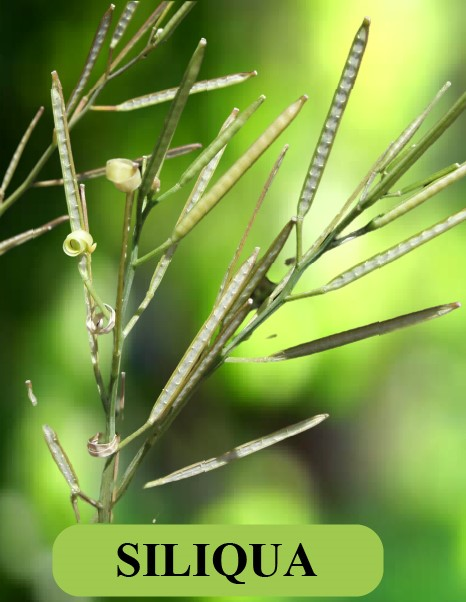
Siliqua fruit occurs in
(a)Hibiscus rosa-sinensis
(b)Solanum nigrum
(c)Brassica campestris
(d)Althaea rosea
Answer
468.9k+ views
Hint: Siliqua is a dry, dehiscent fruit, developed from bicarpellary, syncarpous, and superior ovary with parietal placentation. Siliqua is the characteristic of Cruciferae. Siliques are present in many members of the mustard family.
Complete answer:
This type of fruit is commonly found in Brassicaceae. This is a long, narrow, many-seeded fruit that develops from a superior bicarpellary ovary with two parietal placentae. It dehisces from below upwards by both the sutures Here the ovary is one-chambered at first, but later on, it becomes two-chambered because of the development of a false septum, which extends from one placenta to another. Siliqua is a dry fruit that separates at maturity into two or four segments called valves, leaving a persistent partition that bears the seeds. A typical silique is an elongated capsule, such as in cabbage. A silicle, or silicula, is a short and broad silique, as in the shepherd's purse. The outer walls of the ovary usually separate when ripe, then being named dehiscent, and leaving a persistent partition.
Additional Information: -Hibiscus rosa-sinensis has an accessory fruit developing from the thalamus.
-Solanum nigrum has a simple, dehiscent fruit known as a legume. It is developed from the monocarpellary, superior, and unilocular ovary.
-Althaea rosea has Carcerulas type of fruit. It is a dry schizocarp that develops from the bicarpellary, syncarpous, superior ovary.
So, the correct answer is 'Brassica campestris'.
Note: -Siliques are present in many members of the mustard family, Brassicaceae, but some species have silicles instead.
-Some species closely related to plants with true siliques have fruits with a similar structure that do not open when ripe; these are usually called indehiscent siliques.
-When a siliqua fruit becomes much shorter and flattened and as broad as it is long with a few seeds, it is called silicula, e.g., Capsella and candytuft.

Complete answer:
This type of fruit is commonly found in Brassicaceae. This is a long, narrow, many-seeded fruit that develops from a superior bicarpellary ovary with two parietal placentae. It dehisces from below upwards by both the sutures Here the ovary is one-chambered at first, but later on, it becomes two-chambered because of the development of a false septum, which extends from one placenta to another. Siliqua is a dry fruit that separates at maturity into two or four segments called valves, leaving a persistent partition that bears the seeds. A typical silique is an elongated capsule, such as in cabbage. A silicle, or silicula, is a short and broad silique, as in the shepherd's purse. The outer walls of the ovary usually separate when ripe, then being named dehiscent, and leaving a persistent partition.
Additional Information: -Hibiscus rosa-sinensis has an accessory fruit developing from the thalamus.
-Solanum nigrum has a simple, dehiscent fruit known as a legume. It is developed from the monocarpellary, superior, and unilocular ovary.
-Althaea rosea has Carcerulas type of fruit. It is a dry schizocarp that develops from the bicarpellary, syncarpous, superior ovary.
So, the correct answer is 'Brassica campestris'.
Note: -Siliques are present in many members of the mustard family, Brassicaceae, but some species have silicles instead.
-Some species closely related to plants with true siliques have fruits with a similar structure that do not open when ripe; these are usually called indehiscent siliques.
-When a siliqua fruit becomes much shorter and flattened and as broad as it is long with a few seeds, it is called silicula, e.g., Capsella and candytuft.

Recently Updated Pages
Master Class 11 Accountancy: Engaging Questions & Answers for Success

Glucose when reduced with HI and red Phosphorus gives class 11 chemistry CBSE

The highest possible oxidation states of Uranium and class 11 chemistry CBSE

Find the value of x if the mode of the following data class 11 maths CBSE

Which of the following can be used in the Friedel Crafts class 11 chemistry CBSE

A sphere of mass 40 kg is attracted by a second sphere class 11 physics CBSE

Trending doubts
10 examples of friction in our daily life

One Metric ton is equal to kg A 10000 B 1000 C 100 class 11 physics CBSE

Difference Between Prokaryotic Cells and Eukaryotic Cells

State and prove Bernoullis theorem class 11 physics CBSE

What organs are located on the left side of your body class 11 biology CBSE

Write down 5 differences between Ntype and Ptype s class 11 physics CBSE




